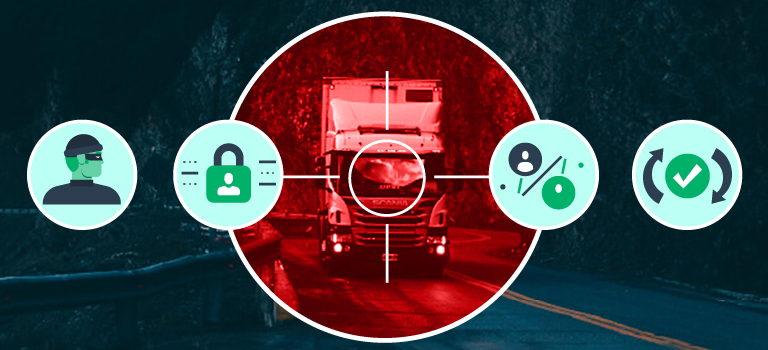The rise of digital services, automation, and greater intelligence — namely through analytics — has vastly improved the logistics industry, fleet management notwithstanding. But a particular caveat comes with digitization — it’s more vulnerable to cyber threats. While the technology’s convenience and benefits are worth the risks, that doesn’t mean cybersecurity professionals should ignore them either.
Of course, it helps to know attack vectors or vulnerable areas cybercriminals might target. By securing these common weak points, the network, systems, and users — including drivers — are much safer.
1. Broad Data Access Privileges
People must have access before interacting with the systems, software and even hardware in some cases. This can be as simple as creating a login account and establishing a secure connection to something more involved, like proprietary hardware with pre-configured access — such as a business laptop or an on-site security badge. Whatever the case, professionals should strictly monitor this with the ability to grant or revoke access in real-time. Access should also be as minimal as possible, staying locked to a select few authorized and mission-critical personnel.
Insider threats are a serious issue and happen more often than some may realize. They can also occur because of employee negligence and not necessarily due to malicious actions. For example, staff might share passwords to a secure account or reuse the same passwords for personal and business accounts. Being able to lock out a user when nefarious or suspicious activity is detected can be the difference between an operation-wide disaster or a minor issue that’s fixed relatively quickly.
2. Outdated Hardware and Software
Similar to how operating systems like Microsoft Windows are constantly receiving security patches and bug fixes in updates, so too are the hardware and software elements involved in a smart fleet system. Everything must be maintained, from the IoT devices and vehicles’ sensors to the system terminals used to monitor the fleet and analyze data.
If a vendor handles this, then it’s simply a matter of ensuring they’re keeping up their end of the bargain. If it’s dealt with in-house, a dedicated team should monitor and administer the necessary updates. Always log this information so there’s a record of service for each piece of hardware or software.
3. Not Enlisting Help
Cybersecurity is an incredibly involved and complex facet of digital operations. Most businesses do not have the resources to maintain a proper system, keep everything up to date, install new hardware, monitor network access and so on. This is why organizations often bring on a full-size IT team if it’s being handled in-house.
Sometimes it is best to enlist help from outside the organization or hire security experts with the resources and time to maintain everything. Fleet management software and hardware vendors sometimes extend these services, but it’s also possible — and recommended — to go right to an expert cybersecurity source.
4. Unencrypted Wireless Communications
Data or digital information is at the heart of an operation and its fleet. There is a veritable treasure trove of data to monitor, such as fuel statistics, safety incident tracking, engine hours, inspection results, current whereabouts and routes. At any given time, the data is passed to individual vehicles or routed to the control system, generally back at headquarters. It’s often transmitted wirelessly, which means it’s incredibly vulnerable to snooping and other Man-in-the-Middle (MITM) attacks. The effects could be disastrous if the information fell into the wrong hands.
That’s why all wireless data and communications should be encrypted, with no exceptions. Encryption essentially scrambles the data, protecting it behind an encryption key, like locking it in a safe. The difference is if the information is compromised, a cybercriminal cannot read or interpret it without the encryption key. It appears scrambled and looks like nonsense. It also means telemetry and smart fleet equipment must be capable of high degrees of encryption. At the very least, the data should be encrypted before being sent to another party.
5. Deprioritizing Cybersecurity
Unfortunately, cyber threats and vulnerabilities will always exist, and there’s no way around them. Burying heads in the sand and pretending it’s not an issue is not the right way to approach it, nor is treating cybersecurity like an afterthought. Cybersecurity should be prioritized heavily with any data operations, using proactive strategies adopted early on before data-related activities are in full swing.
Involve stakeholders in cybersecurity and data protection measures. Train employees — including those being onboarded. Identify and prioritize cybersecurity threats and make sure the team understands which are the most damaging and how they can protect against them. Create a cyber-attack playbook so everyone understands what to do if and when an event does occur. Finally, treat every new process or system with the respect it deserves and ensure they are well-protected foundationally.
6. Not Understanding New Technologies
Shiny new technology and systems that purport to offer a vast supply of benefits and efficiency improvements are hard to pass up, such as modern telematics, which comes with various benefits for commercial and consumer-based use. But before implementing or adopting any new technologies, an understanding must exist. Proponents must know the vulnerabilities, limitations and risks associated with bringing in the latest technology and what that means for the greater operation.
Does the company have the resources to protect and maintain these systems? If not, what’s the best way to secure those resources, including potentially outsourcing security management? What else will be necessary to keep the technology operational? What security vulnerabilities will the new tech introduce?
Making the Fleet Better with Data and Strong Cybersecurity
It’s important to remember that the security of related systems is paramount, especially as modern fleets swap over to data-based operations. While data can undoubtedly make fleets better, faster, and stronger, it does introduce cyber risks and sometimes obscure weaknesses. Cybersecurity professionals must address these six potential vulnerabilities to ensure their fleet data is as secure as possible.
Oscar Collins
Tags: Encryption, Fleet Data, Hardware, Software, Vulnerabilities


